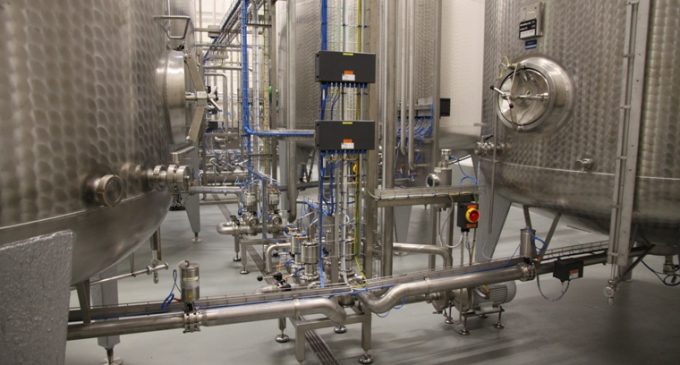GEA Commissions the Mast-Jägermeister SE Blending System

After GEA completed the production tests for spirits manufacturer Mast-Jägermeister SE at its new “South Production” plant in Wolfenbüttel, Germany, the production plant went into commercial operation in April 2018. Mast-Jägermeister SE requires a completely self-sufficient and multifunctional plant at its headquarters in Wolfenbüttel that allows product changeovers between classic Jägermeister liqueur and other spirits. GEA received the order for the entire process technology in June 2016 and installed it last year.
Flexible product changeover with GEA process technology
On a site covering 1,200 square meters, Mast-Jägermeister SE has built another production facility next to its existing “North Production” plant in Wolfenbüttel-Linden, where base ingredients are received, stored in tanks and blended. The aim is to react flexibly to additions to the product range and changes in demand.
“The new blending system has to meet the growing demands of Mast-Jägermeister SE in such a way that we can blend different products and make their changeover quick and flexible,” explains Dr Berndt Finke, Head of Production and Raw Goods Management at the Lower Saxony-based company. “The technology used in the new plant ensures this – with a high level of precision and process reliability.”
The core of the “South Production” plant is GEA’s 7-component in-line blending system. This is where the Jägermeister base ingredients are enriched with pure water, alcohol, caramel and liquid sugar. In future, Jägermeister will always be able to activate two additional components for the production of other products.
“The expensive base ingredients used by Jägermeister do not allow for any waste and losses in the production process,” says GEA’s Project Manager Uwe Kolkmann, summing up the most important criteria. “We have planned a very large spirit blending system for our customer with a capacity of 30,000 liters per hour. This equates to around 42,000 0.7-liter bottles. The key to maximum efficiency and reliability lies in the dosing and cleaning of the blending system.”
Mass flow meters for precise dosing
Where the main plant still used a conventional blending pump which dosed by volume, the new blending system uses GEA’s precise mass flow meters. These are based on the current properties of the base ingredients – because alcohol content, Brix value of the sugar, and densities may well vary. The manufacturing formulas are stored in an integrated database: The quantities are calculated using a specified master formula and then corrected if they differ from the specifications in the master formula. In comparison, the volume doses of the old plant were rigid because they processed each ingredient part regardless of the densities and percentages – with each stroke of the pump.
Part of the fully automated blending system is the redundant server-client system with operator stations – which visualizes the processes, controls the batches for all base ingredient tanks, blending tanks, finished goods storage tanks, and controls the flow path as well as enables traceability.
 Because Jägermeister will be blending a large number of ingredients for varying end products at its “South Production” plant, the base ingredients must be emptied with minimal loss into the respective target tank on their way through the widely branched pipe system. It is also important to avoid aroma carry-over, because even the smallest amounts of the intensely aromatic herbs and spices typical for these products could spoil a whole following batch. Therefore, the cleaning process is of particular importance. “We clean the pipelines with hot ultra-pure water when changing the product, which in turn has to be completely removed from the pipeline in order to exclude product dilutions with water. To do this, we use proven GEA pigging technology,” explains Kolkmann.
Because Jägermeister will be blending a large number of ingredients for varying end products at its “South Production” plant, the base ingredients must be emptied with minimal loss into the respective target tank on their way through the widely branched pipe system. It is also important to avoid aroma carry-over, because even the smallest amounts of the intensely aromatic herbs and spices typical for these products could spoil a whole following batch. Therefore, the cleaning process is of particular importance. “We clean the pipelines with hot ultra-pure water when changing the product, which in turn has to be completely removed from the pipeline in order to exclude product dilutions with water. To do this, we use proven GEA pigging technology,” explains Kolkmann.
However, hygienic pipe pigs made of plastic are not readily usable in areas of alcohol processing that are subject to explosion hazards: They could charge themselves electrically as they advance through the pipes at indefinable speeds to push out the alcoholic media. “For this reason, we have installed special hygienic solutions for Mast-Jägermeister SE in the areas of alcohol processing that are subject to explosion hazards,” says Kolkmann. “We only use nitrogen as a propellant for pigging alcoholic media. The system could explode with compressed air.” GEA implements the ATEX directives for water-polluting substances as well as for explosion protection.
Leakage spaces are hermetically sealed
The directives state that switching leakages from valves must not be released into the atmosphere, so that alcohol from the high-percentage base ingredients cannot evaporate. “But if we want to safely separate hostile media such as cleaning media, we need process valves that ordinarily leak during switching,” says the Project Manager. “In order for the plant to be technically leak-proof permanently, we have designed leakage chambers that are hermetically sealed against the room atmosphere.” GEA achieves this by detecting switching leaks in a sealed collecting vessel on the process skid – this solution results from one of its product campaigns.

































